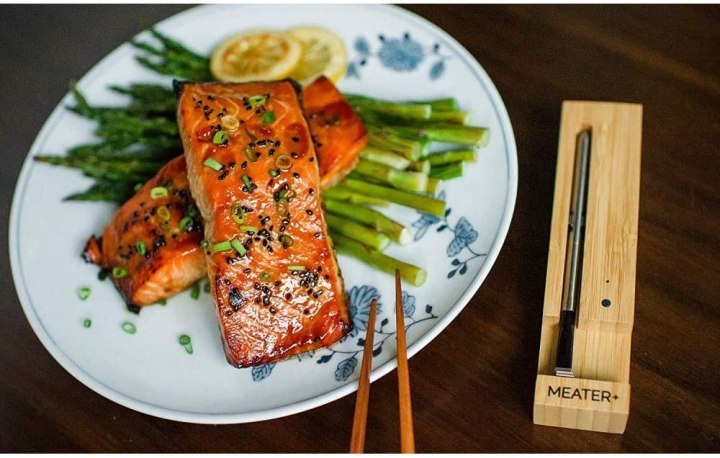Today’s smart thermometers can help manage cooking meats and other foods, especially when measuring internal temperatures is important for getting the right consistency, flavor, and safety. They use apps to send temperatures and alerts to your phone and even provide detailed instructions on how to cook certain dishes or cuts of meat. If you have spent time over the grill or oven, you may be wondering if these smart probes are worth the upgrade. Let’s take a closer look!

Your meat, your rules
One of the first questions to ask is simple: Are you already using a thermometer for your meats and other foods? In your experience, do you prefer using a thermometer to judge the precise internal temperature of the meat to ensure it’s done to perfection?
If that’s true, upgrading to a smart cooking thermometer is a way to up your game and limit the number of holes you put in the meat each time you check the temp. First, these thermometers are often wireless, so there’s no need to worry about managing wires — something that’s already dangerous around a stovetop or grill. And unlike old-fashioned pop-up thermometers and similar options, a smart thermometer is designed to work with an app right on your phone, so you don’t have to open the oven or the grill needlessly. The accompanying app can serve up immediate information about current internal temperatures and send alerts when your meat has reached a certain target. Some even come with a large display to show current temperatures from across the room when your phone isn’t handy.
Smart thermometers are even more valuable if you work with a lot of thick meat cuts like brisket, where knowing the internal temperature is crucial during a longer cooking process. Ultimately, deciding if you need a smart thermometer depends on how much control you like to have over the cooking process and how detail-oriented you are when cooking meats. That brings us to another important consideration…
Time and task management at the grill
One of the biggest advantages of a smart thermometer is that it minimizes the time you’ll spend hovering over cooking meats unless absolutely necessary. With your phone in your pocket, you can get all the updates and do all the monitoring you need, so long as you are within range (some units use Bluetooth, and others will work over a Wi-Fi network).
That feature can be invaluable if you spend a significant amount of time grilling for parties, family gatherings, and other social events. Cooking meat in these settings can be a challenge when there are kids to corral, pets to clean up after, old friends to greet, and appetizers to prepare. A mobile app with current cook temperature information and self-setting timers allows you to be everywhere at once while also keeping an eye on your steak, turkey, fillet, brisket, Beef Wellington, or chicken.

Professional work, catering, and more
There’s another big advantage to smart thermometers: They can manage multiple probes at once. Picks like the Grilleye come with two separate probes and support up to six probes simultaneously. Keeping track of this many temperatures is no problem, thanks to advanced app interfaces.
If you do catering or professional work where you are juggling multiple meat-cooking projects at once, having multiple probes can be vital. The same is true if your family gatherings tend to be on the large side and you are watching over a variety of both fast- and slow-roasting meats.
How accurate is your oven?
It’s also important to consider your current oven’s capabilities. Some modern ovens (and grills) are excellent at setting precise temperatures and providing accurate updates. In those scenarios, you probably don’t need an internal temperature probe. Others may have you guessing at the exact temperature, which is when you’ll need some way of checking to ensure the meat is cooked. Gas ovens, for their advantages, find it difficult to provide data like this. If your oven or grill isn’t providing much data, a smart thermometer can help bridge the gap.

Specialized thermometers
Meat thermometers for the grill and oven may be the most common examples, but smart cooking thermometers can also be used with a variety of other foods or cooking techniques, and in some cases, are invaluable to home cooking. Here are several use cases:
- Smoking: Long-term smoking requires keeping a consistent eye on the temperature. Wireless food probes can help with this and also limit how often you open the smoker.
- Rotisserie: Wireless probes are particularly effective at tracking the temperature of a rotisserie chicken.
- Deep-frying: Oil temps are crucial when deep-frying, so you may want to consider a smart thermometer that can monitor the temp for you while you attend to other tasks.
- Sous vide: Some sous vide devices are quite smart on their own and can share temperature data with their apps. However, if you don’t have one of those, a wireless food thermometer designed for sous vide can help you avoid rookie mistakes.
Smart thermometer costs
Finally, pricing is also a factor when thinking about buying a smart thermometer. Versatile, wireless versions like the MeatStick X Set can cost $100 or more. Simple versions like the Yiou wireless meat thermometer only cost around $30, but you don’t get any app compatibility at that price, and features can be limited. Generally, it’s worth spending a bit more to get the advanced features that make smart thermometers worthwhile.
Interested in learning more? You may want to take a look at our list of food thermometers.



